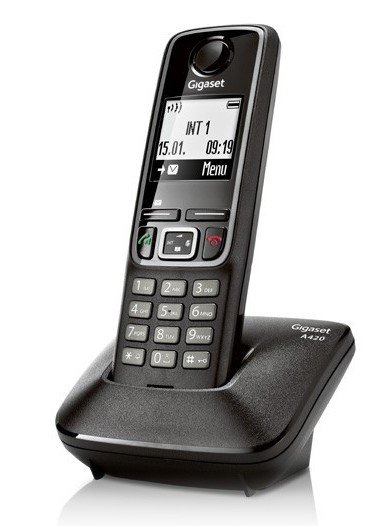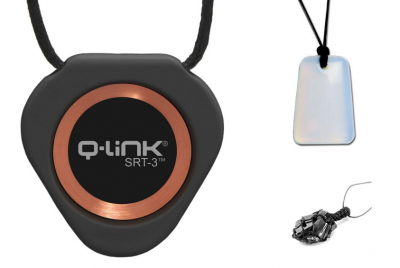When worn correctly, both Bluetooth and wired earbuds offer a lightweight and comfortable way to listen…
Cordless Phone Radiation: Facts, Risks, and How to Eliminate Exposure

*We may earn a commission for purchases made using our links. Please see our disclosure to learn more.
As much as cell phones have taken over, there’s still something to be said for a landline. Maybe you work from home and require a more reliable and secure connection. Or maybe you just prefer the comfortable familiarity that a traditional phone provides. Whatever your reasons, many Americans have opted to maintain their landline connections, either along with or in lieu of a cell phone.
And if you’ve used a traditional phone in the past 20 years, the odds are good that it’s been cordless. Cordless phones provide a fair amount of portability, privacy, and convenience when compared to a wired phone. They allow you to engage in a phone call while traveling throughout your home, yet still offer the reliability some demand from a landline. They represent the best of both worlds for a lot of people.
Cordless phones don’t come without their drawbacks, however. They emit a potentially dangerous form of radiation that could be putting you and your family at risk for serious health problems. And they are doing this in incredibly high quantities — the radiation is emitted from the device 24 hours a day, seven days a week.
Concerned? Read on to learn more.
Cordless phones and radiation
The headset of a cordless phone is constantly transmitting information to and from the base station. Whenever you receive a call or even talk on the phone, all of that has to go through the base station first. This communication between the base station and the receiver is what produces radiofrequency (RF) electric and magnetic field (EMF) radiation.
Radiofrequencies and electric and magnetic fields are regulated by the government, but perhaps not to the extent they should be. Exposure to any one device isn’t the problem — it’s what happens when you are exposed to multiple devices all throughout the day.
Unlike your cell phone, which produces RF-EMF radiation in bursts when you send or receive data, cordless phones emit RF-EMF radiation so long as they are on. Cumulatively, this means cordless phones may be even more dangerous than cell phones when it comes to EMF radiation.
Another problem with cordless phones is our proximity to them, both when in use and in standby. When you use a cordless phone, it is pressed right up against your head. In fact, the signal from the base station to the receiver could be going directly through your brain. That proximity translates to significantly higher exposure to EMF radiation than if you were talking on speakerphone with the device at least six inches from your body.
When not in use, many opt to keep their cordless phone next to them. That is part of the convenience, after all — not having to run to the base station every time the phone rings. However, the closer your proximity to the receiver, the higher your EMF exposure. By keeping your phone glued to your hip, you’re putting yourself at an increased risk.
Risks of exposure
There are many risks of exposure to EMF radiation from cordless phones. Glioma, the most common form of brain cancer, has been linked to EMF radiation by several studies. One Swedish study, for example, found that long-term cell phone use was linked to an increased risk of developing Glioma or other brain cancers. While that study dealt with cell phones, cordless phones emit similarly high levels of EMF and are also held close to the head while in use.
In addition to the increased risk of brain cancer, cordless phones add to your home’s overall EMF level. When the EMF level is high, those who are sensitive may begin to experience seemingly random symptoms such as insomnia, headaches, nausea, itchiness, and depression. Prolonged exposure to high levels has potential ties to leukemia in adults and children. And high levels of exposure may also cause motility and potency issues in sperm, leading to fertility problems for couples who are trying to conceive.
Tips for reducing radiation from cordless phones
Your best bet is to ditch the cordless phone in favor of one with a cord. If that is not realistic or feasible, there are a few things you can do to help protect yourself from EMF radiation.
One thing you can do is unplug your phone when it’s not in use. This is problematic for receiving incoming calls, so you may want to only try this at night. However, any time spent with the base station unplugged will cut down on your home’s overall EMF exposure.
Another thing to try is getting a wired headset that you can connect to the phone. This still allows for portability, and it also creates some distance between your head and the phone. Just remember to get a wired headset, not Bluetooth. A Bluetooth headset gives off EMF radiation of its own.
Also, be careful never to sleep with your cordless phone by the bed at night. Make sure the base station is in a location several feet away from any heavily trafficked areas, and store the phone either on the base station or at least a few feet away from you. Any bit of distance you can put between yourself and the phone will reduce your exposure.
If you must use a cordless phone, it’s also wise to take steps to lower your home’s overall EMF radiation levels. You should consider switching your WiFi connection out for a wired one, for example, and swap out any potentially dangerous light bulbs for safer incandescent ones. There are many steps you can take to reduce your home’s overall EMF radiation levels. If you are going to be raising your home’s levels with a cordless phone, balance things out by reducing the levels somewhere else. It’s not ideal, but it’s a step in the right direction.
Another step you can take to help reduce your exposure is to use an EMF meter. This device measures EMF levels in a given area and can be used to monitor and track your home’s levels. Be sure to check around your beds, couch, and any other area of the home where people frequently inhabit. These are the areas that you ideally want to reduce exposure as much as possible. Even shifting things around — moving your cordless phone’s base station from one side of the room to another — can help reduce EMF levels in heavily-trafficked areas.
If you are in the market for an EMF meter, we usually recommend the TriField TF2, which can detect all forms of EMF radiation, including electric, magnetic, and RF. If you don’t go with the TriField, be sure to pick up a meter that is capable of detecting RF frequencies, particularly if you are concerned about cordless phone radiation.
Better alternatives
There are cordless phones on the market that allow you to reduce the amount of EMF radiation emitted. It’s worth noting, however, that these phones produce lower amounts of radiation in standby mode. That means when the phone is in use, you are still very much exposed to radiation. Try to avoid placing the phone directly against your head for prolonged periods of time, and if possible, use a wired headset.
The European market has several more options but in the United States there is really only one company that currently offers low-EMF cordless phones.
Gigaset cordless phones
Gigaset cordless phones feature an ECO DECT mode that significantly reduces the amount of radiation produced by the receiver. The phone does this by going into standby mode when not in use. The base station only sends out a signal when it is receiving a call, and the receiver only sends a signal when it is making one. Not requiring a constant connection between the receiver and the base station drastically reduces the amount of radiation that the phone generates.
Another benefit of ECO DECT mode is that it saves power. Gigaset claims that ECO DECT phones use up to 60% less energy than Gigaset devices without ECO DECT mode. With most Gigaset models, you will need to purchase a base station separately from the receiver. Also, note that only certain base stations are compatible with ECO DECT mode. Some of the compatible models include the SL780, SL785, A580, A585, AL180, and AL185.
If you’re looking for just a basic cordless phone, the Gigaset E560A is a simple option that features ECO DECT technology. The E560A is available in a two-pack, as well.

For those in search of a few more bells and whistles, there is the A420. This phone comes with the ability to program contacts into an address book, and the manufacturer promotes the phone as having crystal-clear call quality.
Note, too, that just like with the base stations, not all Gigaset receivers are ECO DECT compatible. If you go with an option other than the A270 or A420, you will need to read the packaging to ensure it has ECO DECT mode.
The biggest drawback of Gigaset products is that they are not always easy to locate. As cordless phones become rarer, this will likely only continue. In other words, if you see a good deal on one, jump on it and think about stocking up.
Wired headsets
Whether you’ve got an ECO DECT phone or not, it can’t be stated enough that you should use a wired headset when talking on the phone. Fortunately, there are some great options out there for affordable prices. Corded headsets tend to be much cheaper than wireless ones.

Arama Cell Phone Headset — This headset features a noise-canceling microphone, comfortably fitted earpieces, and in-line controls. It is compatible with most cordless phones, provided you have a traditional headphone jack. This will even work with your smartphone if you have one. Reviewers love the call quality and the price.

Panasonic ErgoFit Earbuds — If you’re looking for an even cheaper option, there are Panasonic’s ErgoFit earbuds. They are available either with or without a microphone in several different colors, including rose gold, black, pink, metallic violet, and more. One drawback is that the in-line controls are primarily intended for those on a smartphone, but at this price point, these are still an excellent option.
Parting words
The EMF radiation emitted by cordless phones is dangerous and certainly worth being aware of. Most modern cordless phones emit this radiation constantly, increasing your home’s overall EMF levels and putting your family at risk. If at all possible, ditch the cordless phone in favor of a wired one. What wired phones lack in convenience, they make up for in safety. The hassle of dealing with a tangled up cord is worth protecting your family from an increased risk of brain cancer.
If you are unable to switch to a wired phone — maybe your office requires you use a specific cordless model, for example — take steps to lower your EMF exposure. Consider outfitting your home for wired internet, or put a protector around your router if you opt to stay wireless. You can buy all incandescent bulbs instead of LED or CFL. You can even put up an EMF-repelling shield along the inside of your wall to protect against a smart meter. Any of these steps will lower your home’s overall EMF levels, which will benefit you in the long run.
In addition to lowering your overall EMF exposure, you should also protect yourself from your cordless phone. Keep the base station away from heavily-trafficked areas of the home, and consider turning it off at night. Better yet, invest in a cordless phone that has ECO DECT mode.
Another recommended step is to always wear a wired headset when talking on the phone. This prevents you from putting the phone (and radiation) directly against your head for a prolonged period of time. Opt for a wired headset over wireless because Bluetooth is another producer of RF-EMF radiation. Cordless phones have become less common as landlines have decreased in popularity. As landlines are still very necessary, however, many still use them for their convenience and reliability. If you must use one, take steps to protect yourself from the harmful effects of EMF radiation.




